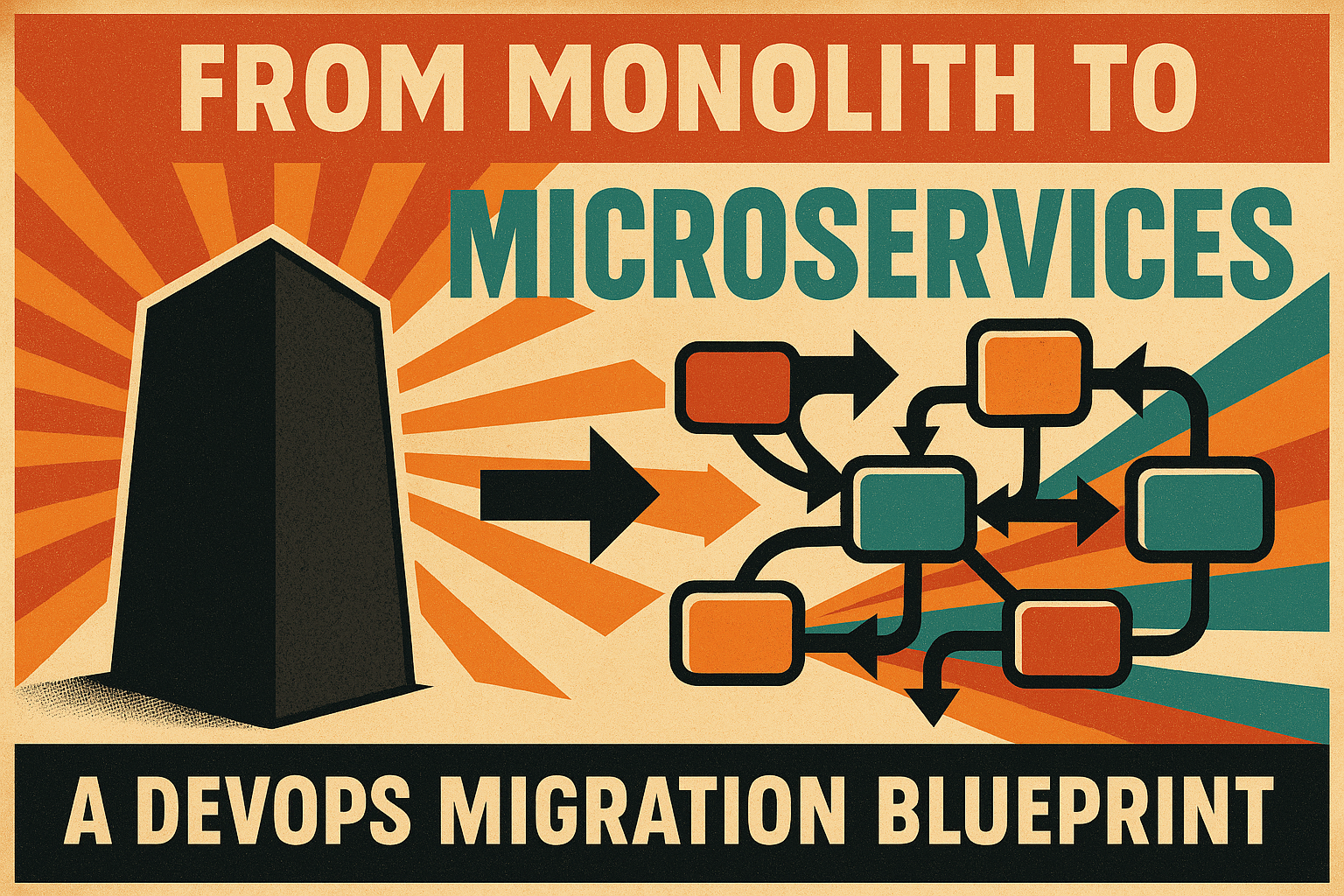From Monolith to Microservices: A DevOps Migration Blueprint

That monolithic codebase you've been wrestling with for years-you know, the one that makes your entire team break into a cold sweat whenever someone says "let's deploy a small fix"? It's time to break up with it. Not a messy breakup, but a strategic, carefully orchestrated transition to a relationship with multiple smaller, more manageable services. This blog post offers a comprehensive roadmap for your microservices migration journey, integrating DevOps principles every step of the way.
The Monolith vs. Microservices: A Tale of Two Architectures
Before diving into the migration process, let's quickly clarify what we're moving from and to.
Monolithic applications are built as a single, autonomous unit where all components are interconnected and interdependent. Think of it as that one-pot pasta recipe-everything cooks together, and if you mess up one ingredient, the whole dish is compromised. While monoliths have served us well for decades, they come with significant limitations in today's fast-paced, cloud-native world.
Microservices, on the other hand, structure an application as a collection of small, loosely coupled, and independently deployable services. Each service in a microservices architecture focuses on a specific business function and communicates with other services through well-defined APIs. It's like a carefully plated gourmet meal where each component is prepared individually to perfection.
Key Characteristics of Microservices:
- Single Responsibility: Each microservice handles a specific task or business function
- Independent Deployment: Services can be developed, deployed, and scaled independently
- Decentralized Data Management: Each service manages its own database
- Polyglot Programming: Different services can be written in different programming languages
- Resilience and Fault Isolation: Failures in one service don't necessarily impact others
- Scalability: Services can be scaled independently based on demand
Why Organizations Make the Leap to Microservices
You're not alone in contemplating this architectural shift. Industry giants like Spotify, Uber, and Netflix have all undergone this transformation for compelling reasons.
Uber started with a monolithic repository that housed all business logic-from matching drivers and riders to handling payments. As the service grew popular, they faced typical monolithic challenges: scalability issues, tightly coupled components, and the need to redeploy the entire codebase for tiny changes.
Similarly, Spotify, an early adopter of microservices and Docker, had containerized microservices running across its fleet of VMs since 2014. However, they eventually migrated from their homegrown orchestration system (Helios) to Kubernetes because "having a small team working on the Helios features was just not as efficient as adopting something that was supported by a much bigger community".
The Migration Blueprint: Your Step-by-Step Guide
Unlike what some tech evangelists might have you believe, migrating to microservices isn't about flipping a switch. It's more like carefully untangling a ball of Christmas lights-methodical, sometimes frustrating, but ultimately rewarding. Here's your DevOps-centric blueprint for making this transition:
1. Comprehensive Assessment and Planning
Begin with a detailed assessment of your monolithic application. Map dependencies, identify tightly coupled components, potential service boundaries, and areas with the most significant impact on performance or maintenance.
This phase isn't just about technology-it's about people and processes too. Consider how your team structure might need to evolve. The best path to clear accountability is to empower small teams that own entire services.
2. Establish DevOps Infrastructure First
You can't run microservices without solid DevOps infrastructure. Before you migrate a single line of code, set up:
- CI/CD pipelines
- Container orchestration (Kubernetes or ECS)
- Comprehensive logging and monitoring tools
As one Reddit user aptly put it: "It's like preparing your new home before moving out of the old one-you don't want to be sleeping on the floor surrounded by boxes".
3. Build Your First Microservice
Start small. Pick a non-critical feature that is loosely coupled with the rest of the monolith. The ideal candidate is functionality that:
- Is already somewhat decoupled
- Doesn't require changes to client-facing applications
- Doesn't use a shared data store
This step helps your team upskill and establishes the minimum DevOps architecture needed to build and deploy microservices.
4. Implement API Gateway and Service Mesh
As you scale beyond a handful of services, managing communication becomes critical. Implement:
- An API Gateway (like Kong or AWS API Gateway) to manage traffic and security
- A service mesh (like Istio or Linkerd) to handle service-to-service communication, retries, and circuit breaking
These tools become "non-negotiable once you scale past 5+ microservices".
5. Use the Strangler Fig Pattern
The Strangler Fig pattern (named after a vine that slowly "strangles" its host tree) involves gradually building a new application around the edges of the old, eventually replacing it entirely.
With this approach, you:
- Redirect specific functionality to new services
- Run old and new systems in parallel
- Gradually decommission parts of the monolith
6. Decouple Vertically, Not Horizontally
Many teams make the mistake of separating layers (UI, business logic, data) horizontally. Instead, decouple in vertical "slices" where each includes functionality encompassing the UI, business logic, and data store.
This approach prevents your database from becoming a velocity-limiting factor.
7. Address Database Challenges
This is usually the most painful part of the migration. Once services are stable, start moving them to their own data stores. Consider using change-data-capture (CDC) tools like Debezium for smoother migrations.
Be careful with distributed transactions-consider event-driven architecture or eventual consistency models.
8. Go Macro, Then Micro
Don't make your initial services too small. Start with fewer, larger services (macro) and break them up later (micro) as you better understand the domain boundaries.
As one expert puts it: "Start with larger services instead of smaller services until you thoroughly understand the domain".
9. Prioritize High-Impact Services
To maximize ROI, prioritize migrating:
- Components with different resource requirements from the rest of the monolith
- Most frequently changed functionality
- Business domains with the highest value
10. Monitor, Optimize, Repeat
Migrating to microservices is never "done." After each service migration, review performance, adjust, and improve your architecture.
Real-World Success Stories: Learning from the Giants
Pipedrive's AWS Migration
Pipedrive, a global CRM software provider, migrated from a private cloud to AWS, moving more than 500 microservices. They developed their own data-migration framework and completed the migration in three 6-week stages over three quarters.
The results were impressive:
- 25% decrease in response time
- 20% reduction in hosting cost per customer
- Virtually eliminated hardware issues and unplanned downtime
Spotify's Kubernetes Adoption
Spotify migrated from their homegrown container orchestration system (Helios) to Kubernetes, citing the "amazing community that had grown up around Kubernetes" as a key factor.
Their primary motivations were:
- Benefiting from added velocity
- Reducing costs
- Aligning with industry best practices and tools
Netflix's Spinnaker Implementation
Netflix developed Spinnaker, a continuous delivery platform specifically designed for microservices. Spinnaker created build pipelines for safe and predictable deployment of microservice applications across multiple cloud providers.
According to Rick Buskens from Google (who collaborated with Netflix on Spinnaker):
"What is important is that Spinnaker is built on experience of deploying industrial-scale applications to the cloud . We know it works, we know it scales. It embodies key best-practices."
Common Challenges and How to Overcome Them
Challenge 1: Identifying Service Boundaries
One of the most challenging problems is identifying microservices boundaries. Two approaches are common:
Solution: Use domain-driven design to identify bounded contexts that define natural service boundaries.
Challenge 2: Distributed Systems Complexity
Microservices introduce distributed systems challenges like network latency, fault tolerance, and message serialization.
Solution: Implement robust monitoring, tracing (like distributed tracing), and circuit breakers to manage these complexities.
Challenge 3: Team Reorganization
Conway's Law suggests that your system architecture will mirror your organizational structure.
Solution: Reorganize teams around business capabilities rather than technical layers. Each team should own the full service lifecycle, from development to operations.
Challenge 4: Data Management
Managing data across services is perhaps the trickiest part of the migration.
Solution: Start with a strategy of "keep the database monolithic at first." Later, carefully extract data with strategies like the Database-per-Service pattern.
The Road Ahead: Embracing Continuous Evolution
Microservices migration isn't a one-time project-it's a journey of continuous evolution. The architectural patterns, tools, and best practices in this space continue to evolve rapidly.
Remember that microservices aren't a silver bullet. As one researcher noted: "Everything in the software development universe is a trade-off, there is no silver bullet, no perfect tech or design".
The most successful organizations approach microservices migration as an opportunity not just to change their architecture, but to transform their entire development and operations culture. By embracing DevOps principles throughout this journey, you're not just breaking up a monolith-you're building a foundation for innovation, speed, and resilience in an increasingly dynamic digital landscape.
And if you find yourself feeling overwhelmed during this journey, remember what every developer says when facing a complex problem: "It worked on my machine!" Unfortunately, that excuse doesn't fly in a microservices world-which is precisely why we need DevOps transformation to accompany our microservices migration.
Now, go forth and decompose that monolith-your future self (and team) will thank you.

